Evaluation of the Light Environment of a Plant Factory with Artificial Light by Using an Optical Simulation
Abstract
1. Introduction
2. Materials and Methods
2.1. Plant Material
2.2. Construction of the 3D models of the Canola Seedlings
2.3. Construction of a 3D Model of a Cultivation Shelf
2.4. Optical Simulation Software
2.5. Validation of the Optical Simulation
2.6. Set Up for the Lighting Designs
2.7. Evaluation Indexes of the Lighting Designs
3. Results
3.1. Estimation Accuracy of the PPFD
3.2. Differences in the PPFD Distributions with or without Plants
3.3. Relationship between the Variables and the Evaluation Indexes for the Lighting Designs
4. Discussion
4.1. Differences in the Light Environments with or without Plants
4.2. Effects of the Lighting Design Variables on the Evaluation Indexes
4.2.1. The Number of BRLED lamps (N)
4.2.2. Distances of BRLED Lamps (D (d))
4.2.3. Light Distribution Characteristics (θh)
4.3. Optimization of the Lighting Design Variables
4.4. Optimization of Lighting Costs in a PFAL via Simulation
5. Conclusions
Author Contributions
Funding
Conflicts of Interest
Appendix A
| Symbol | Description | Unit |
|---|---|---|
| a | Parameter of BRLED lamp distance | - |
| b | Parameter of BRLED lamp distance | - |
| C | Conversion coefficient between radiant flux and photosynthetic photon flux | µmol J−1 |
| CV | Coefficient of variation | % |
| d | Parameter of BRLED lamp distance | cm |
| D | Normalized d | - |
| I(θ) | Photosynthetic photon intensity at θ in vertical angle | µmol s−1 sr−1 |
| Imax | Photosynthetic photon intensity at 0° in vertical angle | µmol s−1 sr−1 |
| N | Number of BRLED lamps | - |
| PF | Measured photosynthetic photon flux density | µmol m−2 s−1 |
| PF‘ | Estimated photosynthetic photon flux density | µmol m−2 s−1 |
| RF‘ | Estimated radiant flux density | W m−2 |
| s | Area of 1 polygon | cm2 |
| S | Area of 1 leaf 3D model | cm2 |
| U | Coefficient of utilization for the lighting system | % |
| Yi | Position on Y-axis of the i-th lamp from the front of the cultivation shelf | cm |
| α | Expornent of cosθ in Equation (10) | - |
| θ | Vertical angle | ° |
| θh | Half-value angle of photometric curve | ° |
| Φ | Photosynthetic photon flux | µmol s−1 |
| Φl | Photosynthetic photon flux emitted from N BRLED lamps | µmol s−1 |
| Φp | Photosynthetic photon flux entering 1 plant | µmol s−1/plant |
| Φp; CV | Coefficient of variation of Φp | % |
| Φp; total | Total photosynthetic photon flux entering a canopy | µmol s−1 |
References
- Kozai, T. Resource use efficiency of closed plant production system with artificial light: Concept, estimation and application to plant factory. Proc. Japan Acad. Ser. B 2013, 89, 447–461. [Google Scholar] [CrossRef] [PubMed]
- Goto, E. Plant production in a closed plant factory with artificial lighting. Acta Hortic. 2012, 956, 37–49. [Google Scholar] [CrossRef]
- Kozai, T.; Ohyama, K.; Chun, C. Commercialized closed systems with artificial lighting for plant production. Acta Hortic. 2006, 711, 61–70. [Google Scholar] [CrossRef]
- Furuyama, S.; Ishigami, Y.; Hikosaka, S.; Goto, E. Effects of blue/red ratio and light intensity on photomorphogenesis and photosynthesis of red leaf lettuce. Acta Hortic. 2014, 1037, 317–322. [Google Scholar] [CrossRef]
- Kim, S.K.; Jeong, M.S.; Park, S.W.; Kim, M.J.; Na, H.Y.; Chun, C. Improvement of runner plant production by increasing photosynthetic photon flux during strawberry transplant propagation in a closed transplant production system. Kor. J. Hort. Sci. Technol. 2010, 28, 535–539. [Google Scholar]
- Wheeler, R.M.; Tibbitts, T.W.; Fitzpatrick, A.H. Carbon dioxide effects on potato growth under different photoperiods and irradiance. Crop Sci. 1991, 31, 1209–1213. [Google Scholar] [CrossRef] [PubMed]
- Yanagi, T.; Okamoto, K.; Takita, S. Effects of blue, red, and blue/red lights of two different PPF levels on growth and morphogenesis of lettuce plants. Acta Hortic. 1996, 440, 117–122. [Google Scholar] [CrossRef]
- Zhang, X.; He, D.; Niu, G.; Yan, Z.; Song, J. Effects of environment lighting on the growth, photosynthesis, and quality of hydroponic lettuce in a plant factory. Int. J. Agric. Biol. Eng. 2018, 11, 33–40. [Google Scholar] [CrossRef]
- Zou, T.; Huang, C.; Wu, P.; Ge, L.; Xu, Y. Optimization of artificial light for spinach growth in plant factory based on orthogonal test. Plants 2020, 9, 490. [Google Scholar] [CrossRef]
- Graamans, L.; Baeza, E.; van den Dobbelsteen, A.; Tsafaras, I.; Stanghellini, C. Plant factories versus greenhouses: Comparison of resource use efficiency. Agric. Syst. 2018, 160, 31–43. [Google Scholar] [CrossRef]
- Graamans, L.; Tenpierik, M.; van den Dobbelsteen, A.; Stanghellini, C. Plant factories: Reducing energy demand at high internal heat loads through façade design. Appl. Energy 2020, 262, 114544. [Google Scholar] [CrossRef]
- Zhang, Y.; Kacira, M.; An, L. A CFD study on improving air flow uniformity in indoor plant factory system. Biosyst. Eng. 2016, 147, 193–205. [Google Scholar] [CrossRef]
- Akiyama, T.; Kozai, T. Light environment in the cultivation space of plant factory with LEDs. In LED Lighting for Urban Agriculture; Kozai, T., Fujiwara, K., Runkle, E.S., Eds.; Springer Singapore: Singapore, 2016; pp. 91–109. ISBN 978-981-10-1846-6. [Google Scholar]
- Kim, J.W. 3D Plant Model-based Estimation of Light Interception and Photosynthetic Rate of Lettuces Grown under LEDs in Plant Factory. Master’s Thesis, College of Agriculture and Life Sciences, Seoul National University, Seoul, Korea, August 2019. [Google Scholar]
- Kozai, T. Why LED lighting for urban agriculture? In LED Lighting for Urban Agriculture; Springer Singapore: Singapore, 2016; pp. 3–18. ISBN 978-981-10-1846-6. [Google Scholar]
- Takita, S.; Okamoto, K.; Yanagi, T. Computer simulation of PPF distribution under blue and red LED light source for plant growth. Acta Hortic. 1996, 440, 286–291. [Google Scholar] [CrossRef]
- Harbick, K.; Albright, L.D. Comparison of energy consumption: Greenhouses and plant factories. Acta Hortic. 2016, 285–292. [Google Scholar] [CrossRef]
- Fang, H.; Li, K.; Wu, G.; Cheng, R.; Zhang, Y.; Yang, Q. A CFD analysis on improving lettuce canopy airflow distribution in a plant factory considering the crop resistance and LEDs heat dissipation. Biosyst. Eng. 2020, 200, 1–12. [Google Scholar] [CrossRef]
- Qian, T.; Elings, A.; Dieleman, J.A.; Gort, G.; Marcelis, L.F.M. Estimation of photosynthesis parameters for a modified Farquhar–von Caemmerer–Berry model using simultaneous estimation method and nonlinear mixed effects model. Environ. Exp. Bot. 2012, 82, 66–73. [Google Scholar] [CrossRef]
- Son, K.-H.; Ide, M.; Goto, E. Growth characteristics and phytochemicals of canola (Brassica napus) grown under UV radiation and low root zone temperature in a controlled environment. Hortic. Environ. Biotechnol. 2020, 61, 267–277. [Google Scholar] [CrossRef]
- The Illuminating Engineering Institute of Japan. Illuminating Engineering; 1; Ohmsha, Ltd.: Tokyo, Japan, 2012; ISBN 978-4274212611. [Google Scholar]
- Ferentinos, K.P.; Albright, L.D. Optimal design of plant lighting system by genetic algorithms. Eng. Appl. Artif. Intell. 2005, 18, 473–484. [Google Scholar] [CrossRef]
- Buck, G.H.; Hemmerling, R.; Vos, J.; de Visser, P.H.B. Modelling of spatial light distribution in the greenhouse: Description of the model. In Proceedings of the 2009 Third International Symposium on Plant Growth Modeling, Simulation, Visualization and Applications, Beijing, China, 3–13 November 2009; IEEE Computer Society: Los Alamitos, CA, USA, 2009; pp. 79–86. [Google Scholar]
- Kim, J.H.; Lee, J.W.; Ahn, T.I.; Shin, J.H.; Park, K.S.; Son, J.E. Sweet pepper (Capsicum annuum L.) canopy photosynthesis modeling using 3D plant architecture and light ray-tracing. Front. Plant Sci. 2016, 7, 1321. [Google Scholar] [CrossRef]
- Jung, D.; Lee, J.; Kang, W.; Hwang, I.; Son, J. Estimation of whole plant photosynthetic rate of irwin mango under artificial and natural lights using a three-dimensional plant model and ray-tracing. Int. J. Mol. Sci. 2018, 19, 152. [Google Scholar] [CrossRef]
- de Visser, P.H.B.; Buck-Sorlin, G.H.; van der Heijden, G.W.A.M. Optimizing illumination in the greenhouse using a 3D model of tomato and a ray tracer. Front. Plant Sci. 2014, 5. [Google Scholar] [CrossRef] [PubMed]
- Both, A.; Ciolkosz, D.; Albright, L.D. Evaluation of light uniformity underneath supplemental lighting systems. Acta Hortic. 2002, 183–190. [Google Scholar] [CrossRef]
- Shimomura, N.; Imai, S. Optimizing illuminance distribution using genetic algorithm. J. Illum. Eng. Inst. Japan 2006, 90, 90–96. [Google Scholar] [CrossRef][Green Version]
- Yoshida, M.; Yoneda, S.; Fujii, S.; Morita, H.; Sogo, T. Genetic algorithm approach to a lighting design problem for desired illuminance. J. Sci. Technol. Light. 1999, 83, 137–138. [Google Scholar] [CrossRef]
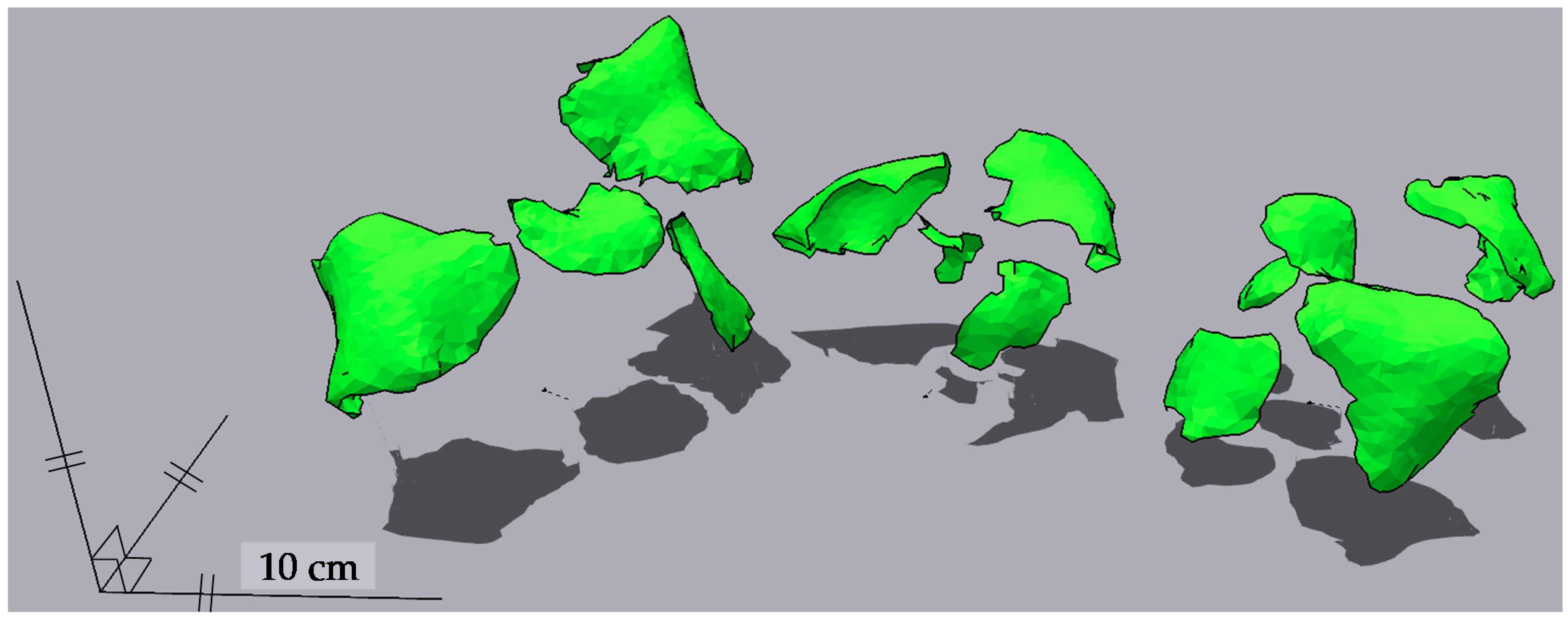
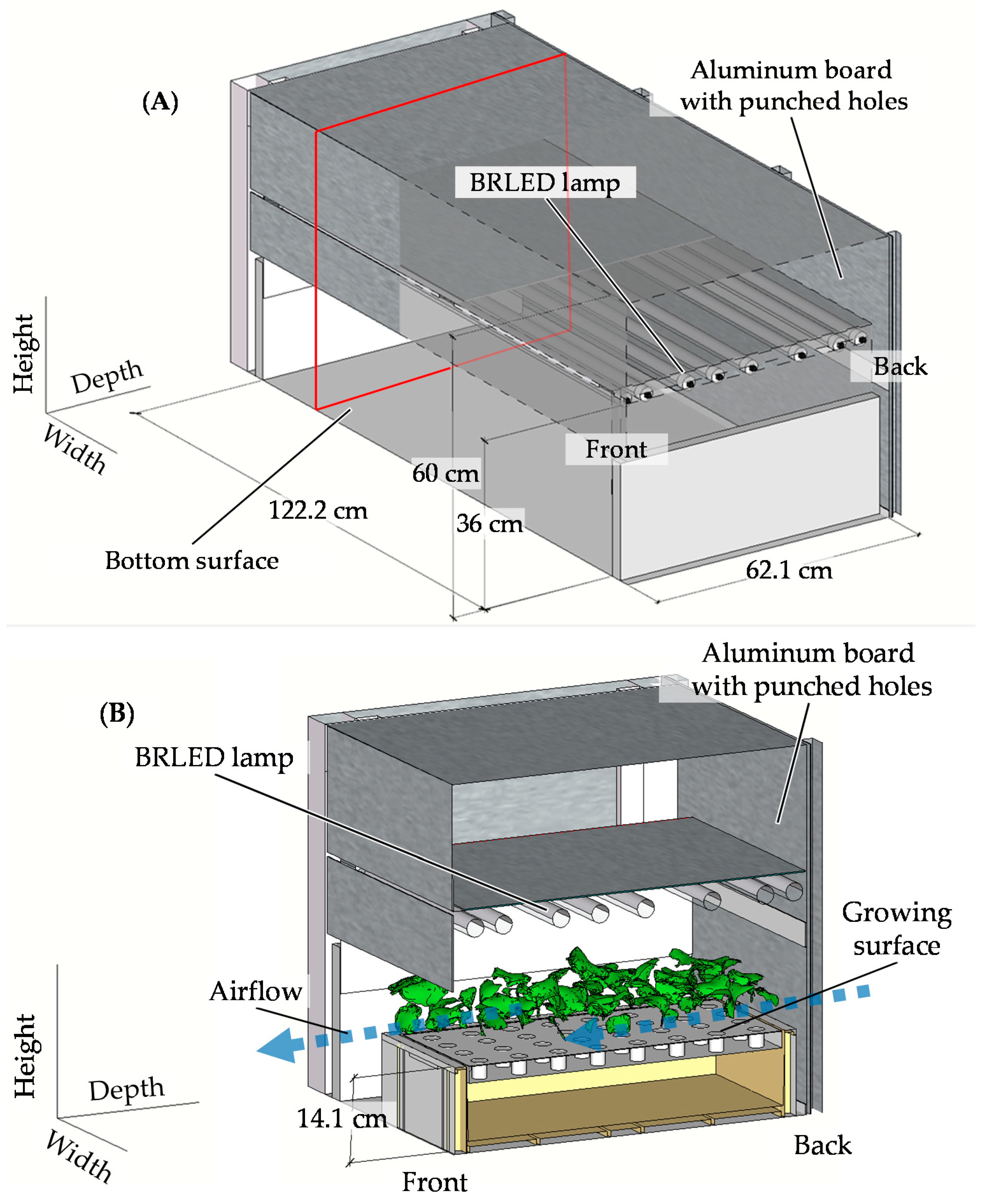
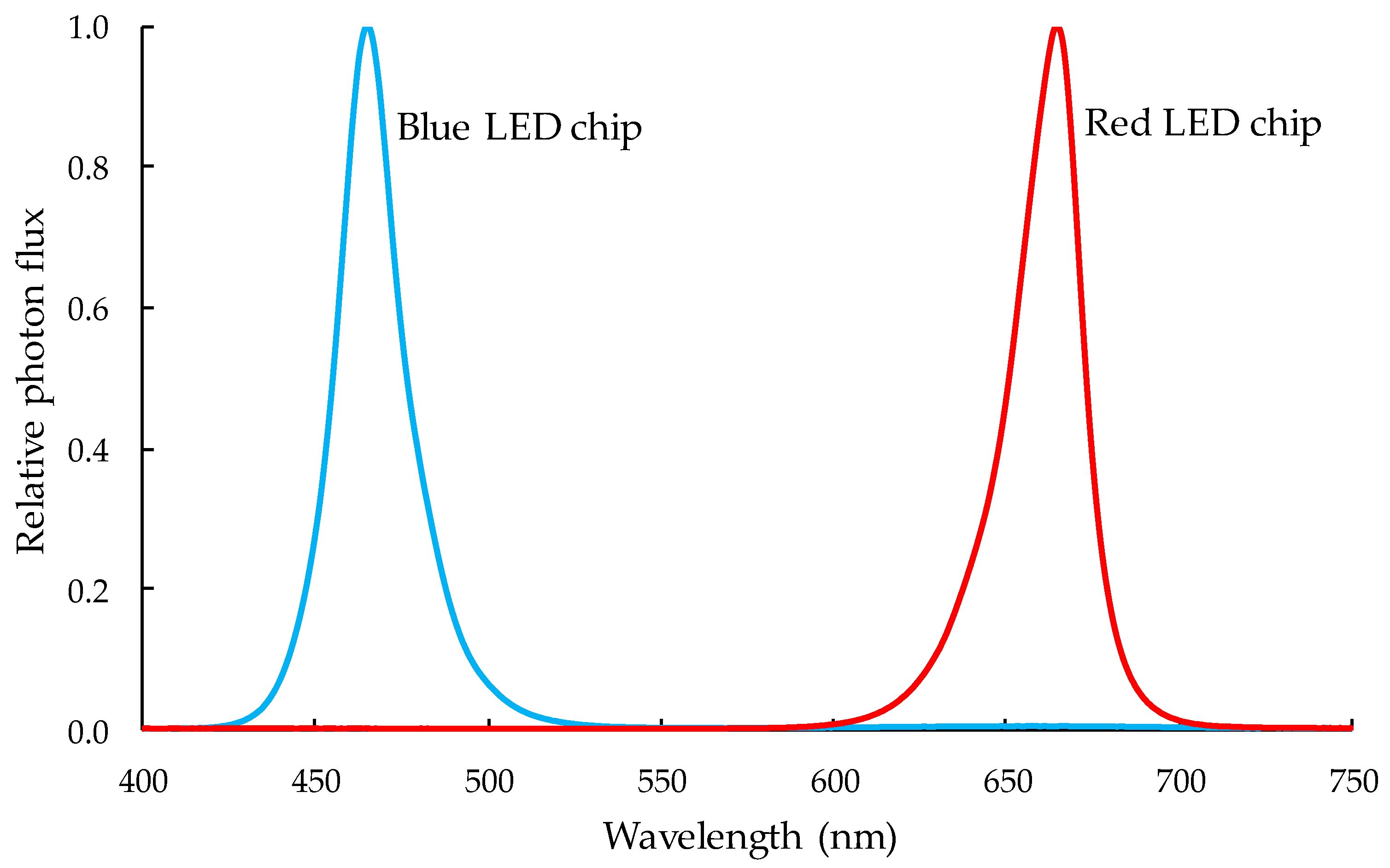

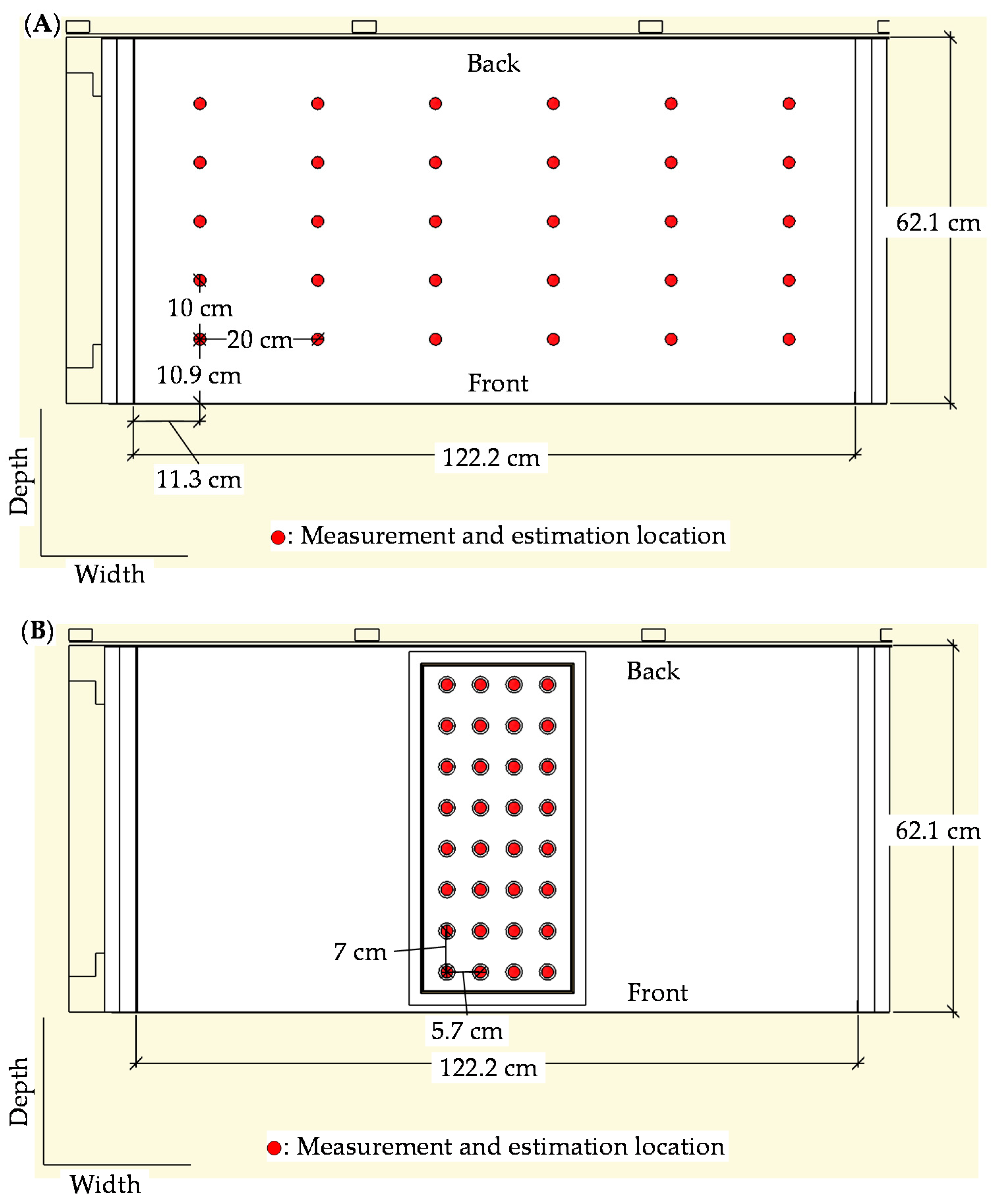
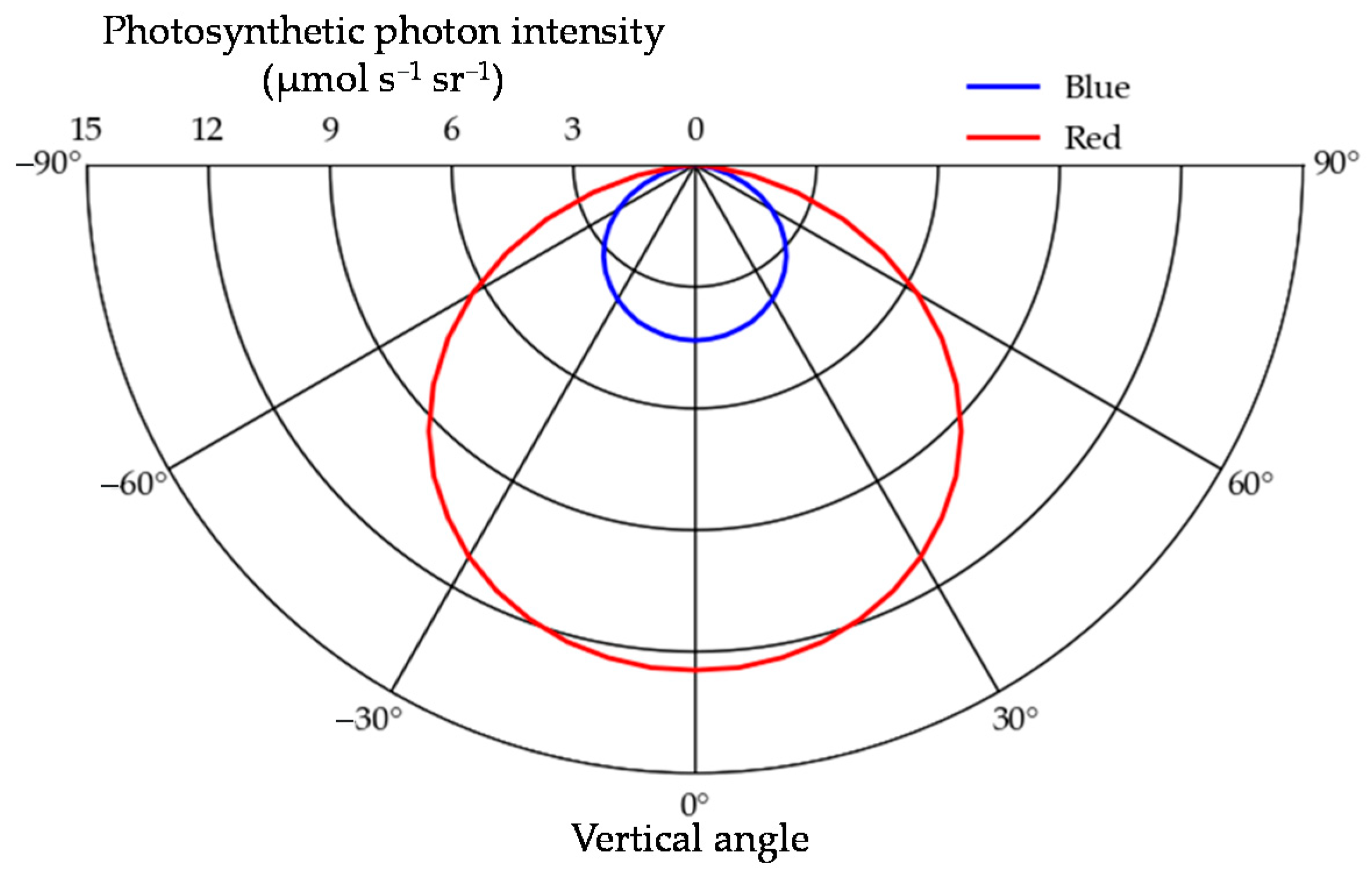

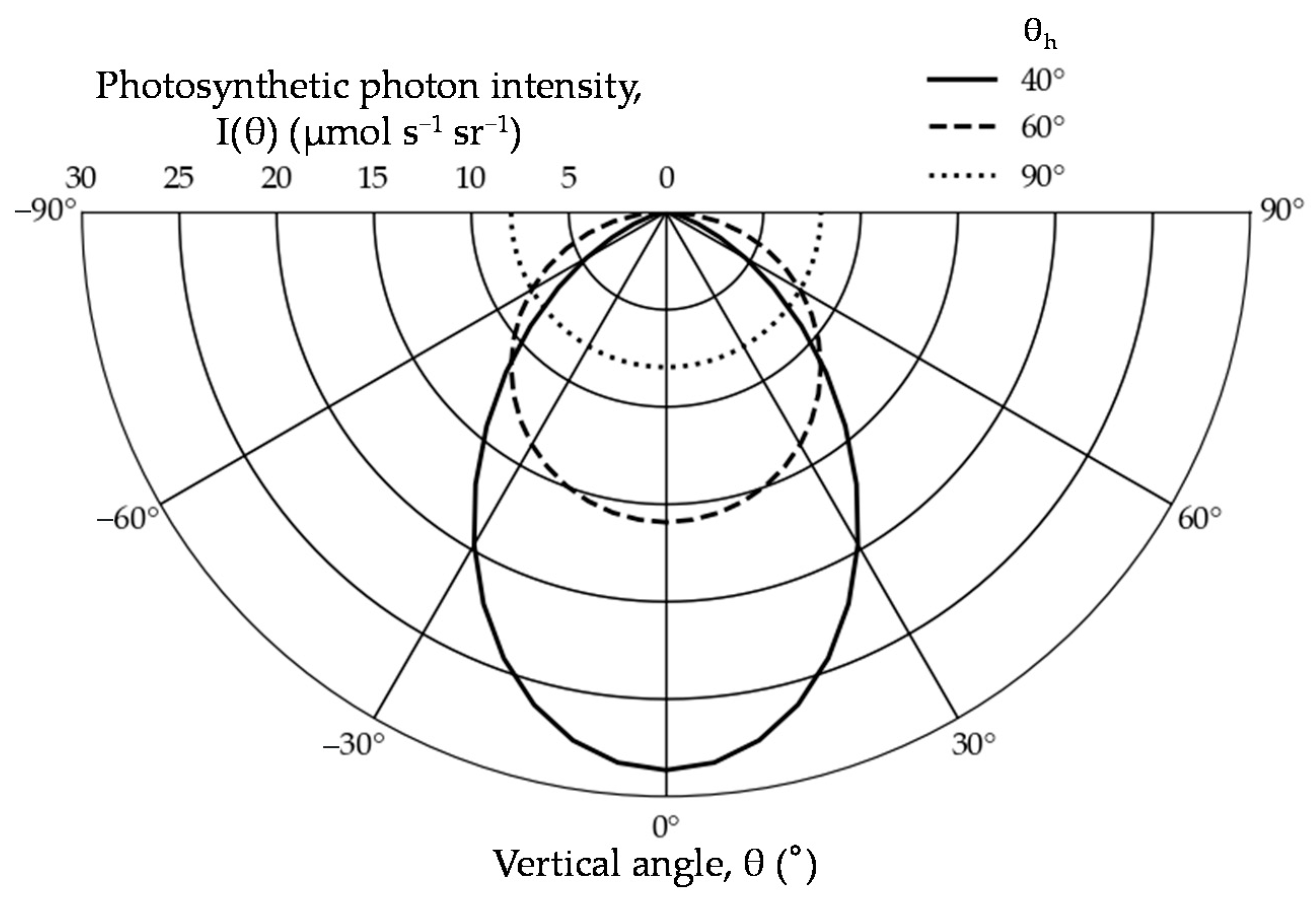

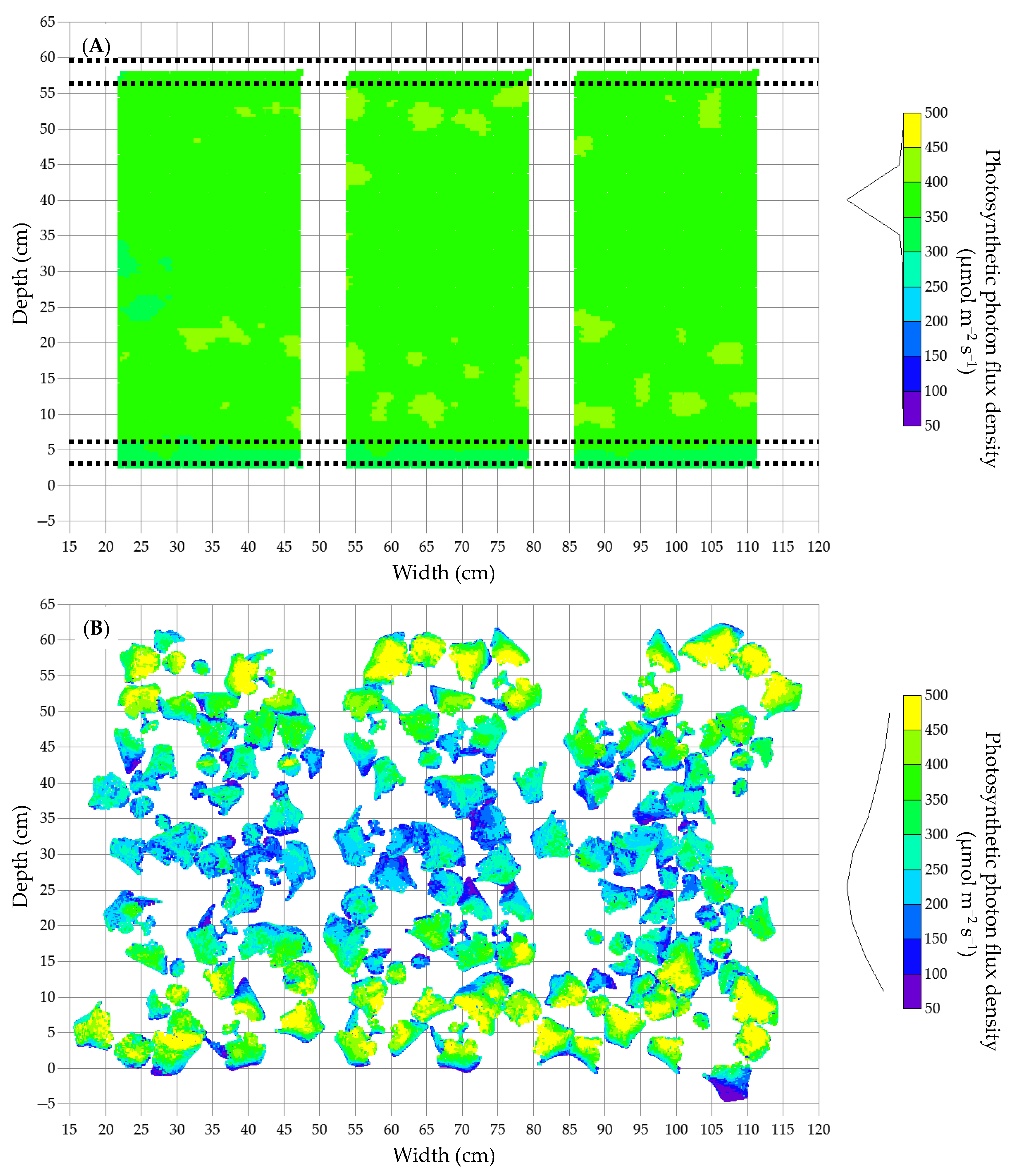

| Material | Reflectance (%) | Transmittance (%) | ||
|---|---|---|---|---|
| Blue Light | Red Light | Blue Light | Red Light | |
| Young canola leaf | 6.3 | 6.1 | 1.7 | 4.2 |
| Reflection sheet | 91.4 | 90.2 | 8.0 | 9.7 |
| Aluminum back surface | 37.0 | 37.0 | 40.3 | 40.3 |
Publisher’s Note: MDPI stays neutral with regard to jurisdictional claims in published maps and institutional affiliations. |
© 2020 by the authors. Licensee MDPI, Basel, Switzerland. This article is an open access article distributed under the terms and conditions of the Creative Commons Attribution (CC BY) license (http://creativecommons.org/licenses/by/4.0/).
Share and Cite
Saito, K.; Ishigami, Y.; Goto, E. Evaluation of the Light Environment of a Plant Factory with Artificial Light by Using an Optical Simulation. Agronomy 2020, 10, 1663. https://doi.org/10.3390/agronomy10111663
Saito K, Ishigami Y, Goto E. Evaluation of the Light Environment of a Plant Factory with Artificial Light by Using an Optical Simulation. Agronomy. 2020; 10(11):1663. https://doi.org/10.3390/agronomy10111663
Chicago/Turabian StyleSaito, Kota, Yasuhiro Ishigami, and Eiji Goto. 2020. "Evaluation of the Light Environment of a Plant Factory with Artificial Light by Using an Optical Simulation" Agronomy 10, no. 11: 1663. https://doi.org/10.3390/agronomy10111663
APA StyleSaito, K., Ishigami, Y., & Goto, E. (2020). Evaluation of the Light Environment of a Plant Factory with Artificial Light by Using an Optical Simulation. Agronomy, 10(11), 1663. https://doi.org/10.3390/agronomy10111663





